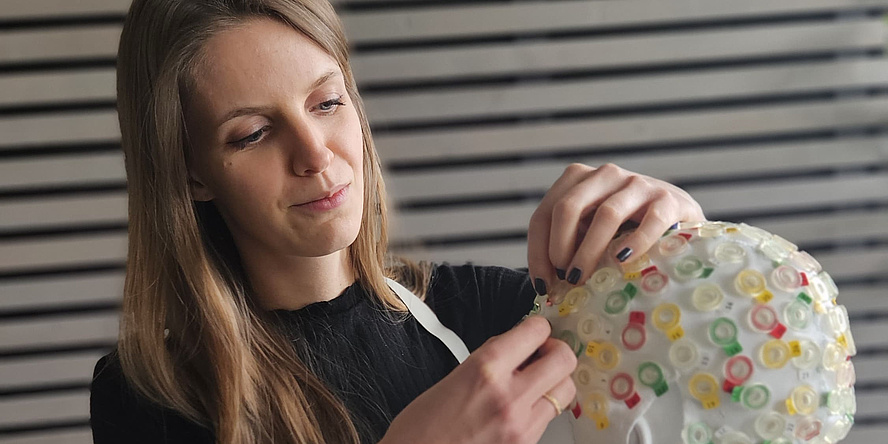With its research endeavours, the Institute of Neural Engineering at Graz University of Technology (TU Graz) aims to develop brain-computer interfaces that enable people with various motor impairments to control prostheses or robotic arms using the power of thought. To this end, the researchers use non-invasive measurement methods such as the EEG.
For research at the institute, see BCI Research: Computer Decodes Continuous Movement from Brain Signals for further information.
Doctoral student Hannah Pulferer has specialised primarily in the patterns in the brain that are associated with error detection in order to automatically correct errors that occur in a brain-computer interface. And, above all, in continuously occurring error perception, such as when driving a car.
In order to recognise patterns in the EEG data that are associated with error processing, test subjects were repeatedly presented with correct and erroneous stimuli in the laboratory. The exact times of the erroneous events were saved. “There is a lot of noise in this data because a number of processes are running simultaneously in the brain at any given time,” explains Hannah Pulferer. “But if we repeatedly present the same stimulus and average out the measured EEG signals, then the stimulus-related processes remain and the noise is cancelled out.”
However, the erroneous stimuli used in research to date are clearly delineated, discrete events that can only be categorised in binary terms as ‘correct’ or ‘erroneous’. This distinguishes them completely from continuous error-prone processes, where a simple subdivision of this kind is no longer sufficient – for example, keeping the car on the road while driving. “In such activities, small corrections have to be made periodically, so you no longer just have to make the decision “error or no error”, but rather record and process the severity of the deviation – for example, how far the car has left the road – and think about how to correct it.” And it is precisely these continual deviations and how they are processed in the brain that are the subject of Hannah Pulferer’s research. In her measurements, test subjects were asked to track a moving object (the snake) on the screen with their eyes and with hand movements (like a computer mouse). In various test conditions, the test subjects were shown a feedback point that increasingly deviated from the snake. “This allowed us to take a very close look at how continuous error processing takes place in the brain,” explains Pulferer.
Versatile applications
This data is relevant for a variety of topics. Brain signals associated with discrete error processing have already been linked to various disorders such as ADHD or depression. “We know that the discrete error potential deviates in these diseases. However, it is still unclear in the discrete case how individual brain regions communicate with each other during error processing. Although we can see that they do, we often don’t know why one region is activated in one scenario and not in another scenario.”
The data on continuous error processing can provide information on how individual areas of the brain actually work together. And of course this would also be interesting for driving safety issues: “For example, we could look at how different workloads – such as when the environment changes from a country road to city traffic – or different distraction factors influence the interaction of different brain regions.”
No predetermined path to technology
Today, Hannah Pulferer talks enthusiastically about her research – a subject that she only warmed to late in her school days. “I wasn’t interested in technology or science at all at first, I wanted to go in the direction of languages. But we had an incredibly good physics teacher at my secondary school who really got me interested in the subject.” Thanks to this influence, Hannah Pulferer began studying Technical Physics at TU Graz, completed her Bachelor’s and Master’s degrees and switched to Biomedical Engineering with a focus on neurotechnology for her PhD. She is currently in the final phase of her PhD studies, which she is completing in a joint-degree programme with Nanyang Technological University in Singapore, where she also spent a large part of last year. “But I want to complete my doctorate in the next few months and hope that I can stay in research afterwards.”
This research area is anchored in the Field of Expertise “Human & Biotechnology”, one of five strategic foci of TU Graz.
You can find more research news on Planet research. Monthly updates from the world of science at Graz University of Technology are available via the research newsletter TU Graz research monthly.

